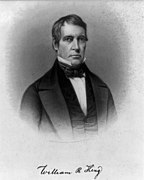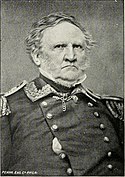Wybory prezydenckie w Stanach Zjednoczonych w 1852 roku
| Państwo | |||
|---|---|---|---|
| Rodzaj | wybory prezydenckie | ||
| Data przeprowadzenia | 2 listopada 1852 (głosowanie powszechne) | ||
| Podstawa prawna | |||
| Głosowanie | |||
| |||
| |||
| |||
| |||

Wybory prezydenckie w Stanach Zjednoczonych w 1852 roku – siedemnaste wybory prezydenckie w historii Stanów Zjednoczonych. Na urząd prezydenta wybrano Franklina Pierce’a, a wiceprezydentem został William R. King.
Kampania wyborcza
Wybory prezydenckie w 1852 roku odbywały się w cieniu, zawartego dwa lata wcześniej, Kompromisu 1850 roku[1]. Partia Wigów nie zdecydowała się udzielić ponownego poparcia dla prezydenta Millarda Fillmore’a[1]. Zawdzięczając swoje dwa wcześniejsze sukcesy wyborcze (z 1840 i 1848 roku) wojskowym, udzielili poparcia kolejnemu bohaterowi wojny z Meksykiem – generałowi Winfieldowi Scottowi[2]. Kandydatura została zaakceptowana po długich dyskusjach i sporach wewnątrzpartyjnych[1]. Na początku czerwca 1852 roku Partia Demokratyczna zwołała konwencję wyborczą w Baltimore[3]. Początkowo o nominację ubiegali się m.in.: Stephen A. Douglas, Sam Houston, James Buchanan, Lewis Cass, William L. Marcy i Joseph Lane[3]. Ponieważ przez długi czas żaden kandydat nie mógł uzyskać wymaganej większości 2/3 głosów, zaczęto szukać kandydatów kompromisowych[3]. W 35. głosowaniu zgłoszono Franklina Pierce’a, który w 49. głosowaniu uzyskał 283, spośród 289 głosów delegatów[3]. Nominację wiceprezydencką uzyskał William King[3]. Pierce nie prowadził kampanii wyborczej, pozostawiając to swojej partii[3]. Partia Wolnej Ziemi wysunęła kandydaturę Johna Hale’a[2]. Większość wyborców wigów z południa kraju odwróciła się od kandydatury Winfielda Scotta, z racji jego poglądów na temat niewolnictwa[1]. Przypieczętowało to klęskę Partii Wigów, która zniknęła ze sceny politycznej[1]. Zawarcie kompromisu 1850 roku, uspokoiło nieco nastroje w społeczeństwie, co przyłożyło się także na słabszy wynik Partii Wolnej Ziemi – zdobyli o połowę głosów mniej, niż w 1848 roku[1].
Kandydaci
Partia Demokratyczna
Partia Wigów
Partia Wolnej Ziemi
Wyniki głosowania
Głosowanie powszechne odbyło się 2 listopada 1852 roku i wzięło w nim udział ok. 3,1 mln osób[4]. Pierce uzyskał 50,8% poparcia, wobec 43,9% dla Scotta i 4,9% Hale’a[4]. Ponadto oddano nieco ponad 12000 głosów na niezależnych elektorów, głosujących na innych kandydatów, m.in.: Daniela Webstera czy Jacoba Brooma[4]. Frekwencja wyniosła 69,6%[5]. W głosowaniu Kolegium Elektorów (zatwierdzonym 9 lutego 1853[6]) Pierce uzyskał 254 głosy, przy wymaganej większości 149 głosów[7]. Na Scotta zagłosowało 42 elektorów[7]. W głosowaniu na wiceprezydenta zwyciężył William King, uzyskując 254 głosy, wobec 42 dla Williama Grahama[7].
Franklin Pierce został zaprzysiężony 4 marca 1853 roku[3].
| Kandydat na prezydenta | Partia | Głosowanie powszechne | Kolegium Elektorów | |
|---|---|---|---|---|
| Głosy | Procent | |||
| Franklin Pierce | Partia Demokratyczna | 1 607 510 | 50,8% | 254 |
| Winfield Scott | Partia Wigów | 1 386 942 | 43,9% | 42 |
| John Hale | Partia Wolnej Ziemi | 155 210 | 4,9% | 0 |
| Łącznie | 296 | |||
| Kandydat na wiceprezydenta | Partia | Kolegium Elektorów |
|---|---|---|
| William R. King | Partia Demokratyczna | 254 |
| William Graham | Partia Wigów | 42 |
| Łącznie | 296 | |
Przypisy
- ↑ a b c d e f M. Jones: Historia USA. s. 228.
- ↑ a b A. Bartnicki: Historia Stanów Zjednoczonych Ameryki. s. 12.
- ↑ a b c d e f g L. Pastusiak: Prezydenci Stanów Zjednoczonych Ameryki Północnej. s. 275.
- ↑ a b c US President – National Vote (ang.). Our Campaign. [dostęp 2017-05-23].
- ↑ Election of 1852 (ang.). CountingTheVotes. [dostęp 2017-05-23].
- ↑ Presidential Election of 1852 (ang.). Biblioteka Kongresu. [dostęp 2017-05-23].
- ↑ a b c Electoral College Box – 1852 (ang.). NARA. [dostęp 2017-05-23].
Bibliografia
- Maldwyn Jones: Historia USA. Gdynia: Latarnia, 2016. ISBN 978-83-65387-02-8. (pol.)
- Andrzej Bartnicki: Historia Stanów Zjednoczonych Ameryki. T. 3. Warszawa: Wydawnictwo Naukowe PWN, 1995. ISBN 83-01-11894-6. (pol.)
- Longin Pastusiak: Prezydenci Stanów Zjednoczonych Ameryki Północnej. Warszawa: Iskry, 1999. ISBN 83-207-1558-X. (pol.)
Media użyte na tej stronie
William Alexander Graham. Library of Congress description: "Gov. Wm. A Graham, N.C. Gov of N.C. 1845-1849, Sec. of the Navy in the cabinet of Pres. Fillmore, July 20, 1850-March 7, 1853, Member of State Senate, 1854, 1862, 1865, Senator in 2nd Confederate Congress"
Portrait of Franklin Pierce (1804–1869) by Mathew Brady. The LoC describes this as "Copy neg. from original ink by Brady after Daguerreotype".
George Washington Julian. Library of Congress description: "Julian, Hon. Geo. Washington of Indiana".
Autor: Internet Archive Book Images, Licencja: No restrictions
Identifier: abrahamlincolnme03mccl (find matches)
Title: Abraham Lincoln and men of war-times : some personal recollections of war and politics during the Lincoln administration ; with introduction by Dr. A.C. Lambdin
Year: 1892 (1890s)
Authors: McClure, Alexander K. (Alexander Kelly), 1828-1909
Subjects: Lincoln, Abraham, 1809-1865 Presidents
Publisher: Philadelphia : Times Publishing Co.
Contributing Library: Lincoln Financial Foundation Collection
Digitizing Sponsor: The Institute of Museum and Library Services through an Indiana State Library LSTA Grant
View Book Page: Book Viewer
About This Book: Catalog Entry
View All Images: All Images From Book
Click here to view book online to see this illustration in context in a browseable online version of this book.
Text Appearing Before Image:
ng with a single detective in it. Lincolnand Lamon entered the carriage and Kenney mountedthe box with the driver. They were in advance of thetime for the starting of the Baltimore train, and theywere driven around on Broad street, as the driver wasinfonued, in search of some one wanted by Kenney andthe detective, until it was time to reach the station. 50 LINCOLN AND MEN OF WAR-TIMES. When there they entered by the public doorway onBroad street, and passed directly along with other pas-sengers to the car, where their berths had been engaged.The journey to Washington was entirely uneventful, andat six in the morning the train entered the Washingtonstation on schedule time. Seward had been advised, bythe return of his son from Philadelphia, of the probableexecution of this programme, and he and Washburnewere in the station and met the President and his party,and all drove together to Willards Hotel. Thus endsthe story of Lincolns midnight journey from Harrisburgto the National Capital.
Text Appearing After Image:
(Photo by Brady, Washington.) IvIEUT.-GENERAL WINFIELD SCOTT. LINCOLNS SORE TRIALS ABRAHAM LINCOLN arrived in Washington on the-tx. 23d of February, 1861, to accept the most appallingresponsibilities ever cast upon any civil ruler of moderntimes. If he could have commanded the hearty confi-dence and co-operation of the leaders of his own party,his task would have been greatly lessened, but it is dueto the truth of history to say that few, very few, of theRepublican leaders of national fame had faith in Lin-colns ability for the trust assigned to him. I couldname a dozen men, now idols of the nation, whose opendistrust of Lincoln not only seriously embarrassed, butgrievously pained and humiliated, him. They felt thatthe wrong man had been elected to the Presidency, andonly their modesty prevented them, in each case, fromnaming the man who should have been chosen in hisstead. Looking now over the names most illustrious inthe Republican councils, I can hardly recall one who en-couraged L
Note About Images
US Flag with 31 stars. In use 4 July 1851–3 July 1858. Created by jacobolus using Adobe Illustrator, and released into the public domain.















